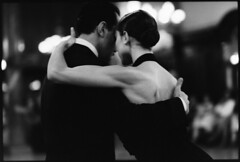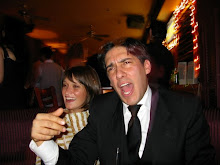
Understanding Human Nature Through Movement: An Interview with Tango Photographer Adriana Groisman
Originally uploaded by lorenzodom
© Adriana Groisman, Osvaldo & Lorena, La Ideal, Buenos Aires, Argentina. Tango, Never Before Midnight series.
(Originally published by En Foco, May 13)
In 2002, Academy award winner Robert Duvall wrote, directed and starred in Assassination Tango, a feature film which follows an assassin who gets caught up in the world of the milongueros–those who frequent the nocturnal dance halls of Argentina. Duvall created this film in honor of a longtime obsession of his – dancing tango with his girlfriend in Buenos Aires.
A year after his film was released, Duvall explained his passion to correspondent Charlie Rose, “It gets in your blood in a quiet way, kind of a sweet thing that sits there. He’s leading, he’s telling her what to do, but she embellishes. But in our politically correct world, up in the United States, they call it the leader and the follower. Down here, they call it the man and the woman. Ha ha.”
Duvall conceded that despite years of dancing it was not easy to make the film, because “You just can’t take a crash course to be a tango dancer in a movie.”
Photographer Adriana Groisman would likely tell you much the same, you can’t just go into a dance hall and start taking pictures, at least not if you wish to capture the subtleties that make this pastime so intriguing to so many who have likewise fallen in love with the dance.
Born in Buenos Aires, Argentina, Groisman has been a photojournalist since 1985, with work appearing in major publications in the USA and abroad. She has been taking photos of the milongueros for over 15 years, and her sophisticated understanding of the people, the culture and the rich meaning in each turn, every pause and all the subtle gestures exchanged between the dancers is clearly visible in her work.
I had a chance to catch up with Adriana at her recent opening to her En Foco Touring Gallery exhibition: Tango, Never Before Midnight (on view through June 21, 2010). Our discussion follows.
Do you remember the first time you used a camera and when you wanted to become a photographer in earnest?
I remember that my father gave me a Kodak Fiesta when I was six years old. However, I did not begin to take photography seriously until I decided to become a photojournalist.
My first real job was as a physical education teacher during the military dictatorships that marred our country from 1976 until 1983. In Argentina it is often known simply as la última junta militar (the last military junta) or la última dictadura (the last dictatorship), because several of them had existed throughout our history.
Initially, I loved being involved in athletics, especially because it endowed one with a great sense of confidence, one that made you believe that no one could repress you.
Alas, reality set in for me and I was disenchanted after having to teach high school students how to march. I did it for three years and then decided that I had enough. At the same time that I was teaching, I was working with abused children and I used to take photos of them while helping out.
Moreover, despite my disheartening experience at work, I loved sports, especially gymnastics. So when Nadia Comăneci , who many consider the greatest gymnast of all time (winner of three Olympic gold medals at the 1976 Summer Olympics, the first gymnast ever to be awarded a perfect score of 10 in an Olympic gymnastic event, and the winner of two gold medals at the 1980 Summer Olympics) came to Buenos Aires in the early eighties, a friend of mine asked me to take pictures of her. It was then that I realized that I loved photography and I particularly loved capturing the grace and grandeur of movement.
A friend of mine who was a photographer in New York at the time knew of my aspirations and encouraged me to make the big move to the Big Apple. He said if I wanted to become a serious photographer, New York City was the place to do it. I arrived in October of 1983, and, based on his advice, I took courses at ICP (the International Center for Photography).
My first job was for an Argentine Magazine, La Semana. I vividly recall my very terrifying first assignment —to interview a criminal. He slammed the door on us.
Things got a lot better though and I quickly fell in love with the myriad interviews of journalists, authors, actors, politicians and others I was assigned to do. An interview, if it is performed well, gives you a level of insight and intimacy that has always fascinated me.
Do you remember the first time you wanted to focus on the life and culture of Tango?
I have long been attracted to documenting sub- or underground cultures. Before I began my Tango project I had spent a substantial amount of time, effort and emotion on a long-term project about the life of transvestites.
I had developed a number of good relationships with my subjects, but then had a falling out after a few heart-breaking experiences. Thus, as devastated as I was, I decided that I couldn’t pursue that project anymore. My saving grace was my next long-term project, the life of the milongueros, the regulars at the Argentinean Tango dance halls, who I would also consider a subculture.
That said, I do not regret my time with the transvestites. Because, much like the Milongueros, I have found that both groups are rather wise about people. It is a bit difficult to express in words and through my photographs even, but the more experienced dancers tell me that they can tell a lot about a person simply by how they embrace you while dancing. Having spent so much time with them, I can fully attest to their deeper understanding of human nature.
Moreover, both of these projects have taught me that it is vital to judge people a lot less, and to be much more accepting of others’ idiosyncrasies, quirks and penchants.
Can you tell us more about your exhibition—Tango, Never Before Midnight.
The show is a work which records the world of the milongas –traditional Argentinean tango balls– and their patrons, the milongueros. Each night at the milonga is a dramatic cycle in itself, an erotically charged arena where issues of power and gender are played out. Fleeting relationships, alliances, rivalries, jealousies and games of seduction occur, leading to the encounters on the dance floor. These negotiations are carried out through furtive glances and minute gestures, parts of a ritual that can go completely unnoticed by outsiders.
Milongueros tend to speak very little; even if they have been dancing with each other for years they never ask each other’s last names, addresses or professions. This is one of the unspoken rules of the “real” milongueros. Another implicit rule is that the invitation to dance is never verbal. Rather, this is done through a complex series of interlocking gazes and body attitudes.
At the milonga, a great social equalizer, class, age and physical appearance recede. The dancing is what counts, the body connection, the feeling for the music.
In many of your Tango photos there is more black than white, more dark than light, seemingly leaving more to be said than to be seen. What are your thoughts on this mode of seeing this world?
Yes, Tango is about the mystery of life. It is a very suggestive art, a rather subtle dance, which to the untrained eye may appear as if nothing is happening, but in reality everything is happening. It is a game of both containment and surrender. An experience that reaches deep, but on the surface remains so subtle.
This is the magic of magic of Tango and what I have tried to capture in my photos for 15 years.
****
Tango, Never Before Midnight, is an En Foco Touring Gallery exhibition at Pregones Theatre from May 1 – June 21, 2010.
Adriana Groisman will be giving an artist talk at the theater on Saturday, May 15 from 1:00 to 2:00 pm. The event is free and open to the public.
Location
Pregones Theatre
571 – 575 Walton Avenue @ 149th Street
Bronx, NY 10451 718-585-1202
For More Information
www.adrianagroisman.com
www.enfoco.org




No comments:
Post a Comment